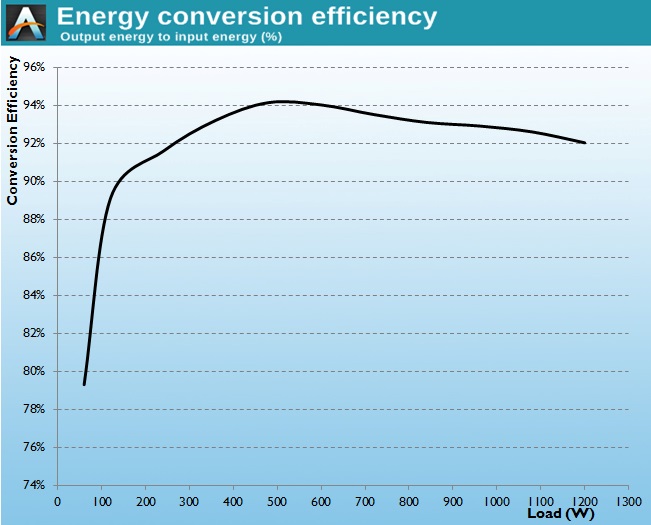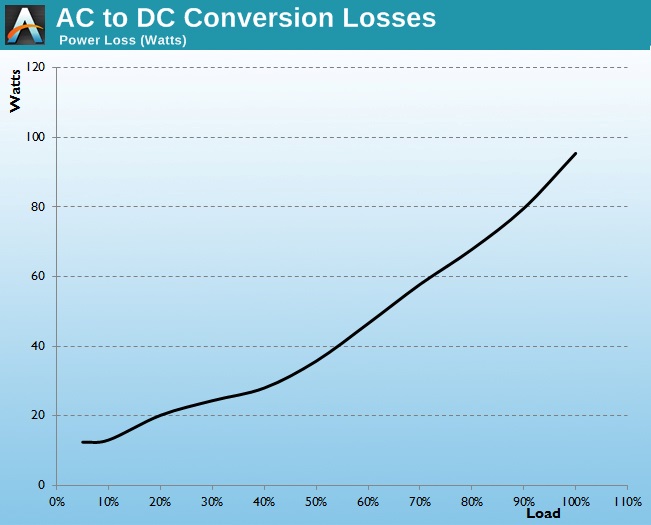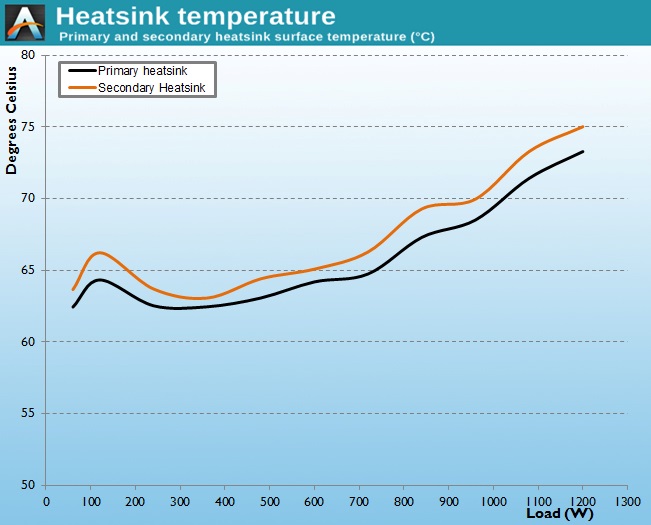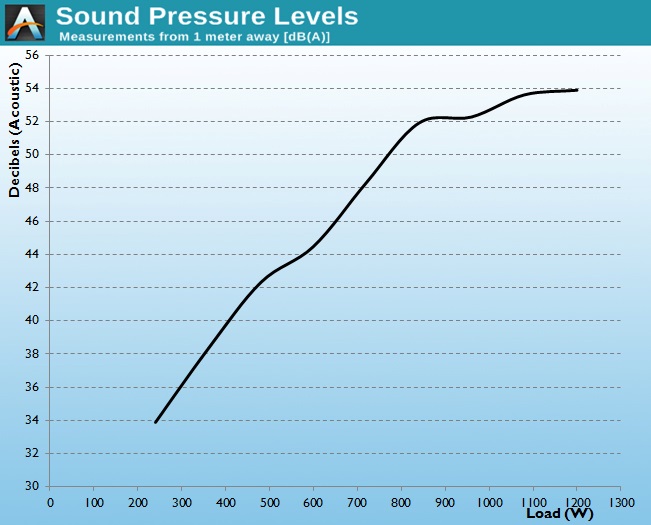Cooler Master V1200 Platinum Power Supply Review
by E. Fylladitakis on November 21, 2014 2:00 PM EST- Posted in
- Cases/Cooling/PSUs
- Seasonic
- 1200W
- Cooler Master
Hot Test Results
As shown in the following tables, the Cooler Master V1200 Platinum offers excellent power output quality. Our instrumentation recorded a maximum ripple of 38mV on the 12V line under maximum load, which is no small feat for a line supplying over 85 Amperes. The severe cross-loading of the voltage lines has little effect on the output stability, and it hardly affects the voltage lines any different than a very heavy balanced load. It also displays excellent voltage regulation, at 0.75%, 0.8% and 1.0% for the 3.3V, 5V and 12V line respectively.
| Main Output | ||||||||
| Load (Watts) | 242.22 W | 604.62 W | 903.35 W | 1199.57 W | ||||
| Load (Percent) | 20.18% | 50.39% | 75.28% | 99.96% | ||||
| Line | Amperes | Volts | Amperes | Volts | Amperes | Volts | Amperes | Volts |
| 3.3 V | 4.26 | 3.35 | 10.66 | 3.34 | 15.99 | 3.33 | 21.31 | 3.32 |
| 5 V | 4.26 | 5.08 | 10.66 | 5.07 | 15.99 | 5.06 | 21.31 | 5.04 |
| 12 V | 17.05 | 12.1 | 42.63 | 12.08 | 63.94 | 12.03 | 85.26 | 11.98 |
| Line | Regulation (20% to 100% load) |
Voltage Ripple (mV) | |||||
| 20% Load | 50% Load | 75% Load | 100% Load | CL1 12V |
CL2 3.3V + 5V |
||
| 3.3V | 0.75% | 12 | 16 | 18 | 20 | 14 | 22 |
| 5V | 0.8% | 16 | 18 | 20 | 24 | 14 | 26 |
| 12V | 1% | 12 | 22 | 30 | 38 | 34 | 18 |
High ambient temperatures have little impact on the performance of the Cooler Master V1200 Platinum, even smaller than that of the almost identical SS-1200XP3. The average nominal load (20-100%) efficiency drops to 93.0% and the maximum efficiency is 94.1% at 50% load. Technically, this unit would maintain its 80 Plus Platinum certification even if the test took place with an ambient temperature of >45°C. (Note that the 80 Plus certification tests take place with an ambient temperature of 25°C.)
As expected, the cooling system maintains a similar profile with the PSU inside the hot box -- the higher ambient temperatures just make it even more aggressive. The fan once again starts at 20% load, but the speed of the fan is now rapidly increasing as soon as the load increases any further. Even at 50% load, our instrumentation was reading over 44dB(A), a sound pressure level that would surely be rated as uncomfortable by the vast majority of consumers. If the load is over 800 Watts for prolonged periods of time, the sound pressure level goes over 50dB(A), creating a hostile environment for any typical consumer/commercial users.















27 Comments
View All Comments
E.Fyll - Friday, November 21, 2014 - link
"....is *not* very logical - a noisy...."bebimbap - Friday, November 21, 2014 - link
If i remember correctly, at the same frequency every +3dB sound seems 2x as loud and every +10dB sound seems 10x as loud. as different humans are more/less sensitive to different frequencies even at the same dB.jmke - Tuesday, November 25, 2014 - link
that counts indeed for dB. But notice that the sound levels are measured in dBA. A weighed it takes +10dBA to have make it seem twice as loud, not +3dBA ;-)DanNeely - Friday, November 21, 2014 - link
How does the 24pin ATX cable connect to the PSU? I'm assuming the 2 ports labeled 18P M/B and 10P M/B are involved; but since they have a total of 4 more pins than needed I'm curious what's going on since it's apparently more than just splitting the connector to make it easier to arrange everything on their backplate.vred - Friday, November 21, 2014 - link
You are right about the connectors. This is not a one-to-one connection between the two sides of the cable.redmist77 - Friday, November 21, 2014 - link
Exactly how many people out there are running 4-way SLI? They seem to be horribly over-represented in tech news.vred - Friday, November 21, 2014 - link
Because we are awesome?redmist77 - Saturday, November 22, 2014 - link
Both of you?vred - Saturday, November 22, 2014 - link
No, we're speaking of ourselves in plural. Do you mean there's... *another* one?rpg1966 - Friday, November 21, 2014 - link
The conclusion says: "it could be a good choice for systems that require a lot of power and operate under harsh conditions, as well as for gamers and professionals that do not prioritize low-noise operation over reliability and power quality".Isn't that completely wrong? For any gamer with a <800W system, the PSU will be be completely silent. Since that power limit covers almost all real-world gamers, it seems to me that it's the ideal (if expensive) PUS for "gamers ... that do prioritize low-noise operation, as well as desiring reliability and power quality".